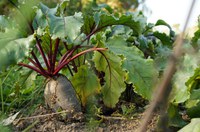Prairie Fare: A root to love — The colorful benefits of beets
(Click an image below to view a high-resolution image that can be downloaded)
I recently served as the beet thinner and harvester at a community garden where I volunteer. Some of our harvest goes to a local food pantry, while the helpers take home a share of fresh-from-the-garden goodness.
Harvesting root vegetables like beets feels like a treasure hunt — you never quite know what’s hiding under the leaves.
Besides red, purple and golden yellow, beets can also be white. Harvesting them at golf-ball size or slightly larger will ensure they are not woody.
I “earned” many beets as my share. Some beets were purple-red and others were a gold-orange color.
My family eyed the container of beets by the sink with a mix of curiosity and caution. Their expressions said it all: “What is she going to have us eat now?”
People have a somewhat love-hate relationship with beets. Some people find beets to taste and smell earthy, but roasting mellows their flavor. Their flavor comes from a harmless compound called geosmin, which is also found in mushrooms and spinach. Our noses are sensitive to this aroma.
Beets, along with carrots, parsnips and radishes, are called taproots. These roots act as the nutrition storage unit for the plant. In England, a beet is more commonly known as beetroot.
What can you do with beet greens? You can enjoy beet greens in salads after thoroughly rinsing them with water. Sauté the greens in a small amount of oil as a side dish.
In ancient times, people were more interested in eating the leaves in soups and other dishes than in eating the bulbous root.
To prepare beets, rinse and scrub them to remove the soil. Leave about an inch of the stem on the top of the beet before cooking or roasting. Otherwise, beets tend to bleed their red color.
Beets can be roasted, cooked or pickled. Learn how to pickle beets from the “Making Pickled Products” guide found online from North Dakota State University Extension.
Beets are rich in fiber, potassium and antioxidants. In fact, the violet-rose color of beets, called “betanin,” appears to have anti-inflammatory properties.
Some researchers have linked eating beets to improving athletic performance or even reducing the risk of cancer. Researchers have studied the potential for beet juice to promote brain health and heart health.
The natural red color from beets is being used in some types of frosting and yogurt.
Eating a lot of red beets or beet juice, however, can cause urine to appear pink or red — this is called beturia, and it’s harmless. Don’t head to the emergency room.
To put my little harvest to good use, I made borscht — a traditional beet soup — with some help from a time-tested recipe by Alma Janke Schott in the Germans from Russia Heritage Collection at the NDSU library.
The NDSU Extension publication “Exploring North Dakota’s Foodways: Germans from Russia” is available online. The potato rolls and cucumber salad recipes included in the publication would be tasty accompaniments.
Borscht
4 cups beets with leaves (or substitute 2 cups spinach, with stems removed, for beet leaves)
1 tablespoon olive oil or your favorite oil
1 pound beef, cut into small cubes (stew meat or short ribs recommended)
2 tablespoons butter
1 onion, diced
2 cups celery, chopped
1 ¾ cups fresh tomato, diced
1 teaspoon fresh dill
5 cups beef broth, low sodium (to make broth, you can use beef short ribs; simmer in 2 quarts water for 3 hours)
1 teaspoon salt
½ teaspoon black pepper
2 cups cabbage, chopped
2 tablespoons vinegar
1 tablespoon sugar
To prepare beets: Trim leaves from the beets and leave an inch of stem attached. Rinse the beet leaves (or spinach). In a 6-quart kettle, add water to the beets until they are fully covered. Bring to a boil, then lower the heat to a simmer. Cover for about 45 minutes or until beets are tender. Drain and slip off the skins from the beets. Cut beets in small pieces to measure 4 cups.
Meanwhile, heat 1 tablespoon of oil in a large skillet over high heat. Add the beef and sear for about 5 minutes, stirring frequently, until browned. Transfer the meat and any juices to a bowl. In the same 6-quart kettle, melt butter; add onion and celery and cook for 5 minutes. Add the tomatoes, dill, broth, salt and pepper. Bring to boil; lower the heat to simmer and cook covered for 5 to 10 minutes. Stir in beet tops or spinach, cabbage, beef, vinegar and sugar. Carefully stir in cooked beets. Simmer covered for 5 to 7 minutes more to heat through. Serve with sour cream and fresh dill garnish.
Makes eight servings. Each serving has 120 calories, 6 grams (g) fat, 7 g protein, 10 g carbohydrate, 2 g fiber and 420 milligrams sodium.
(Julie Garden-Robinson, Ph.D., R.D., L.R.D., is a North Dakota State University Extension food and nutrition specialist and professor in the Department of Health, Nutrition and Exercise Sciences.)
NDSU Agriculture Communication – July 17, 2025
Source: Julie Garden-Robinson, 701-231-7187, julie.garden-robinson@ndsu.edu
Editor: Dominic Erickson, 701-231-5546, dominic.erickson@ndsu.edu




